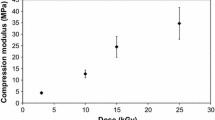Abstract
Degradation behavior is one of the most important characteristics of biomedical materials for their applications. Herein, we systematically investigate the in vitro degradation behaviors of γ-glycidoxypropyltrimethoxysilane (GT) and/or epoxy-terminated polydimethylsiloxane oligomer (ES)-modified gelatin hybrid materials in physiological conditions. Their microscopic appearance, chemical composition, thermal performance, and mechanical properties at different degradation periods were thoroughly characterized by a series of measurements. It was found that the degradation behavior of silica–gelatin hybrids could be modulated by controlling the proportion of GT to ES oligomers. In particular, ES/GT-G hybrid as a result of combination of ES and GT, exhibited a faster degradation rate than that of GT-G hybrid when using merely GT, and showed a more homogeneous degradation behavior during the degradation process. Additionally, these silica–gelatin hybrids showed low cytotoxicity to human renal epithelial cells, and the cell viability was all above 83%. This work is helpful for a further insight into the in vivo degradation of silica–gelatin hybrid scaffolds, which are promising in biomedical applications.

Highlights
-
In vitro degradation behaviors of silica–gelatin hybrids were tested in physiological conditions.
-
Degradation behaviors of silica–gelatin hybrids could be modulated by the proportion of GT to ES oligomers.
-
ES/GT-G hybrid showed a faster and more homogeneous degradation performance.
-
The prepared silica–gelatin hybrids exhibited cytocompatibility in vitro.









Similar content being viewed by others
References
Artzi N, Oliva N, Puron C, Shitreet S, Artzi S, Ramos AB, Groothuis A, Sahagian G, Edelman ER (2011) Nat Mater 10(9):704–709
Parenteaubareil R, Gauvin R, Berthod F (2010) Materials 3(3):1863–1887
Ferreira AM, Gentile P, Chiono V, Ciardelli G (2012) Acta Biomater 8(9):3191–3200
Depan D, Shah JS, Misra RDK (2013) Polym Degrad Stab 98(11):2331–2339
Zhuang H, Zheng JP, Gao H, Yao KD (2007) J Mater Sci Mater Med 18(5):951–957
Zulkifli FH, Hussain FSJ, Yusoff MM (2014) Polym Degrad Stab 110(110):473–481
Su K, Wang C (2015) Biotechnol Lett 37(11):2139–2145
Gómez-Guillén MC, Giménez B, López-Caballero ME, Montero MP (2011) Food Hydrocolloid 25(8):1813–1827
Goncalves S, Chiossone-Kerdel JA, Bianco AS, Ercolino JM, Hernandez-Rojas J (2015) Acta Otolaryngol 135(1):14–25
Zheng R, Duan H, Xue J, Liu Y, Feng B, Zhao S, Zhu Y, Liu Y, He AJ, Zhang WJ, Zhou GD (2014) Biomaterials 35(1):152–164
Lei B, Shin KH, Koh YH, Kim HE (2014) J Biomed Mater Res B 102(7):1528–1536
Rutnakornpituk M, Ngamdee P, Phinyocheep P (2006) Carbohydr Polym 63(2):229–237
Xue Y, Wang L, Shao Y, Jin Y, Chen X, Lei B (2014) Chem Eng J 251(251):158–164
Kaali P, Momcilovic D, Markström A, Aune R, Czel G, Karlsson S (2010) J Appl Polym Sci 115(2):802–810
Rhee SH, Choi JY, Kim HM (2002) Biomaterials 23(24):4915–4921
Tonda-Turo C, Gentile P, Saracino S, Chiono V, Nandagiri VK, Muzio G, Canuto RA, Ciardelli G (2011) Int J Biol Macromol 49(4):700–706
Han X, Du W, Li Y, Li Z, Li L (2016) J Appl Polym Sci 133(8) https://doi.org/10.1002/APP.43059
Lei B, Shin KH, Noh DY, Jo IH, Koh YH, Choi WY, Kim HE (2012) J Mater Chem 22(28):14133–14140
Mahony O, Tsigkou O, Ionescu C, Minelli C, Ling L, Hanly R, Smith ME, Stevens MM, Jones JR (2010) Adv Funct Mater 20(22):3835–3845
Huang Y, Onyeri S, Siewe M, Moshfeghian A, Madihally SV (2005) Biomaterials 26(36):7616–7627
Australia S (2009) Biological evaluation of medical devices-part 5: tests for in vitro cytotoxicity. International Organization for Standardization: Geneva, Switzerland
Mosmann TJ (1983) Immunol Methods 65(1-2):55–63
Sisson K, Zhang C, Farachcarson MC, Chase DB, Rabolt JF (2009) Biomacromolecules 10(7):1675–1680
Du WN, Han XN, Li ZJ, Li YP, Li, LX, Wang, KY (2015) J Appl Polym Sci 132(44) https://doi.org/10.1002/APP.42727.
Wojciechowska P, Pietras P, Maciejewski H (2015) Adv Polym Tech 33:36–38
Du WN, Dai GC, Wang BC, Li ZJ, Li LX (2018) J Appl Polym Sci 135(20) https://doi.org/10.1002/app.46264.
Ning CQ, Mehta J, Elghannam A (2005) J Mater Sci 16(4):355–360
Komsa-Penkova R, Koynova R, Kostov G, Tenchov BG (1996) Biochim Biophys Acta 1297(2):171–181
Neshati Z, Bahrami AR, Eshtiaghhosseini H, Matin MM, Housaindokht MR, Tabari T, Edalatmanesh MA (2012) Cytotechnology 64(5):485–495
Galia CR, Macedo CA, Rosito R, Mello TMD, Moreira LF (2008) Clinics 63(6):801–806
Bayraktar O, Malay O, Ozgarip Y, Batigã NA (2005) Eur J Pharm Biopharm 60(3):373–381
Acknowledgements
This work was supported by the National Natural Science Foundation of China (No. 21376153) and Suzhou International Science and Technology Cooperative Project (SH201108). The authors would thank Wang Zhonghui (College of Light Industry, Textile, and Food Engineering, Sichuan University) for her great help in SEM observation.
Author information
Authors and Affiliations
Corresponding authors
Ethics declarations
Conflict of interest
The authors declare that they have no conflict of interest.
Electronic supplementary material
Rights and permissions
About this article
Cite this article
Zhang, Z., Han, X., Du, W. et al. Comparison and evaluation of in vitro degradation behaviors of organosilicone-modified gelatin hybrids. J Sol-Gel Sci Technol 89, 370–379 (2019). https://doi.org/10.1007/s10971-018-4883-8
Received:
Accepted:
Published:
Issue Date:
DOI: https://doi.org/10.1007/s10971-018-4883-8




